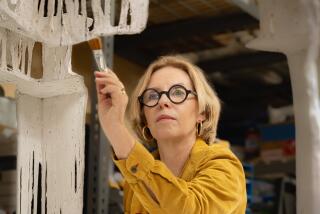Book review: ‘Collector Without Walls: Norton Simon and His Hunt for the Best’ by Sara Campbell
Collector Without Walls
Norton Simon and His Hunt for the Best
Sara Campbell
Yale University Press: 496 pp., 2,250 illus., $65
Of all the eccentricities attributed to Norton Simon, his lack of interest in publishing scholarly books about his art collection is among the most baffling. Was Simon, one of the 20th century’s premier collectors, spurning the academic establishment to which he didn’t belong? Or just being himself, a brilliant contrarian and proud of it?
Whatever the reason, it isn’t that Simon didn’t care about what others thought of the trove he assembled over 35 years and ultimately housed at his museum in Pasadena. He was famous for soliciting the opinions of his household staff and office workers as well as eminent art historians and dealers as he amassed European artworks from the Renaissance to the 20th century and Asian objects created over a span of 2,000 years. He also made sure that visiting experts’ assessments of his acquisitions were carefully recorded.
From 1954 to 1989, Simon and his foundations spent more than $125 million on art, acquiring nearly 8,000 works. But at his death, in 1993, the primary publication about his collection was “Masterpieces From the Norton Simon Museum,” a 208-page picture book with a brief introductory text.
“Collector Without Walls: Norton Simon and His Hunt for the Best,” an authoritative history of the collection written by Sara Campbell, the museum’s senior curator, is a striking reminder of how much has changed at the Pasadena institution since the demise of its founder. Operating in refurbished facilities with public programs and extended visiting hours, the museum is engaged in an ambitious effort to produce publications on par with those of comparable institutions. The project, launched in 1994 by the Norton Simon Art Foundation, has produced seven collection catalogs and more are on the way.
Campbell’s book is part of that program, but it stands alone as an essential guide to the formation and evolution of Simon’s entire collection. With the insight and diplomacy of a trusted, longtime employee — who joined Simon’s staff in 1969, when his art enterprise was based in his corporate offices in Fullerton — she has written a personal narrative about a high-rolling, tough-dealing, predictably unpredictable collector. It’s a compelling story, followed by a chronological catalog of acquisitions — including many he later sold and a few he repurchased.
“It was an exasperating, demanding, and utterly magnificent experience to work for him and to watch the collection change and grow,” Campbell writes in the preface, before tracking Simon’s obsessions with French Impressionism, South and Southeast Asian art and European Old Masters.
In the convoluted case of Edouard Manet’s “Still Life With Fish and Shrimp,” Simon bought the Impressionist painting in 1960 for $110,000 and consigned it to Sotheby’s in 1973 — with a guarantee that the auction house would buy the picture for $1.5 million if bidding didn’t go that high. When no buyer emerged, the firm kept its promise and tried to sell the artwork privately, but had no luck until five years later when Simon returned. He offered to buy it back for $400,000 if he was the winning bidder or even the under-bidder on the “Branchini Madonna,” a 15th-century Italian altarpiece scheduled to go on the block.
In a deal that still causes eyes to roll in the art world, Simon snagged the “Madonna” for $1.1 million and took back the still life for an additional $400,000. He was delighted to have paid a bargain price for the Italian Renaissance painting, which turned out to be a jewel after it was cleaned. Simon being Simon, he was even happier to have won bragging rights about making a big profit on the Manet without losing it.
A restless force with a head for figures, Simon parlayed a $7,000 investment in a bankrupt bottling plant into Hunt Foods Inc., a national food-processing powerhouse. Then came an empire that included Wesson Oil, Canada Dry Corp., McCall’s Publishing, Wheeling Steel and Avis Car Rental.
When he turned to collecting, at 48, he adapted an advertising slogan, “Hunt for the Best,” to his quest. He had no experience in the field, but quickly found his way to top dealers and made news with major acquisitions, including Rembrandt’s “Portrait of a Boy” for $2.2 million, Zurbaran’s “Still Life With Lemons, Oranges, and a Rose” for $2.7 million, Raphael’s “Madonna and Child With Book” for $3 million and the inventory of Duveen Brothers gallery, reportedly for $15 million but actually for $4 million.
The list of purchases does not include the contemporary collection built by the Pasadena Art Museum and taken over by Simon in 1974, when he bailed out the sinking institution. At that point, he gave up his “Museum Without Walls,” a traveling exhibition program, and reorganized a museum with walls to his own liking. Campbell doesn’t shy away from the fallout caused by the deal. She also writes frankly about such thorny matters as her boss’ inability to yield responsibility to a series of short-lived museum directors.
Simon was unable to relinquish control of the museum, “his most enduring legacy,” as Campbell puts it. But he provided for its future, as this book shows in fascinating detail.
Muchnic, a former Times staff writer, is author of “Odd Man In: Norton Simon and the Pursuit of Culture.”
More to Read
Sign up for our Book Club newsletter
Get the latest news, events and more from the Los Angeles Times Book Club, and help us get L.A. reading and talking.
You may occasionally receive promotional content from the Los Angeles Times.






